A long time ago, Wizards of the Coast printed Hermit Druid.
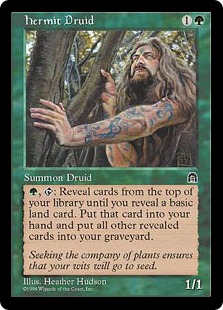 This little critter may look harmless enough, but he soon got into trouble – big trouble for such a little guy. Once players figured out that they could build decks without basic lands, they realized that they could activate this guy to empty their entire library into their graveyard. For years, players had tried to prevent their opponent’s from doing just that. But the printing of so many new cards that could be played or used from the graveyard changed all that.
This little critter may look harmless enough, but he soon got into trouble – big trouble for such a little guy. Once players figured out that they could build decks without basic lands, they realized that they could activate this guy to empty their entire library into their graveyard. For years, players had tried to prevent their opponent’s from doing just that. But the printing of so many new cards that could be played or used from the graveyard changed all that.
A single activation of this guy allowed players not only to empty the contents of their library into their graveyard, but also to win the game. Krosan Reclamation allowed you to rebuild your library however you wanted, draw and play a spell like Exhume, Corpse Dance, or Reanimate, and win the game with a hasty Sutured Ghoul or some such monster. In other words, a single activation of Hermit Druid triggered a chain of events that led directly and inexorably to victory.
It is understandable, then, that when Type 1.5 was decommissioned and Legacy created in its place, that this little green guy, Hermit Druid, was banned. He has been banned ever since in Legacy.
Given this history, it is surprising that Wizards of the Coast would print not one, but two Hermit Druid variants in Gatecrash:


It is true that these creatures differ from Hermit Druid in a very significant respect. Hermit Druid checks to see if you have a basic land in your deck, and will stop upon hitting one. These Rogues will stop milling upon hitting any land. It is a simple matter to build a deck in eternal formats with only non-basic lands. It is a much greater challenge to build a deck with no lands whatsoever. Yet it is a challenge that is far from impossible.

The obvious model for a deck like this is Goblin Charbelcher decks. Belcher decks appeared in eternal formats almost immediately upon the release of Mirrodin, with Michael Simister’s 3rd Place deck from the 2004 Vintage Championship providing one of the earliest recorded glimpses, and the first high-level finish.
Vintage Charbelcher, by Michael Simister
Even by this point, there had been enough mana accelerant printings to enable designers to build decks with almost no lands. If your intent is to win the game on turn one, then having more than one land in your deck is superfluous, provided that single land can be gotten into play on turn one. Land Grant was used to pull the one or two lands out of Belcher deck in that manner, and to guarantee a successful Belcher activation. Charbelcher lists also quickly emerged in Legacy, and have gone on to appear with some frequency in StarCityGames Open Top 8s, and even capturing 2nd place at the Legacy Championships at GenCon 2010.
Since the first Belcher lists, there have been two critical trends in this archetype relevant to this discussion. First, Wizards has continued to print new mana accelerants and new efficient ways to thin your deck. Cards like Mox Opal and Gitaxian Probe did not exist five years ago. Second, Wizards has unrestricted in Vintage (and unbanned in Legacy) many of the narrow mana accelerants like Chrome Mox and Grim Monolith (which was banned in Legacy and restricted in Vintage).
As a consequence of these trends, Belcher designers have abandoned using any land at all. In the calculus of these players, the cost of running a land is no longer worth the benefit. The benefit of deploying a land as a mana accelerant with Land Grant is apparently no longer worth the risk of hitting the land, even a Taiga, with a Belcher activation and falling short of lethal damage to justify running Land Grant. Ten years ago, Land Grant was a necessity given the relative paucity of alternative mana accelerants. In addition, the risk of getting Land Grant countered is too high, especially since a rule change/errata was adopted that requires you to reveal your hand prior to its resolution.
The idea of no-land decks is a throwback to decks that emerged nearly 20 years ago: decks of the Degenerate Era, which I discuss in my History of Vintage series, that ran no lands at all, and simply used Moxen and Black Loti to accelerate out their plays.
ChannelBall
| Business (20) 10 Wheel of Fortune 10 Fireball Mana Sources (20) 10 Black Lotus 10 Channel |
These land-less Belcher decks point the way toward a potential home or “shell” for Balustrade Spy and Undercity Informer, and suggest, at the outset, their potential viability. If Belcher decks can Top 8 in Legacy and Vintage, then surely these Rogues can as well. After all, they are far more efficient.
Playing and activating Goblin Charbelcher costs 7 mana in all (4 to cast, and 3 to activate Belcher). In that respect, Undercity Informer and Balustrade Spy offer a tremendous advantage in that they only cost 4 mana to play and activate. In a strict comparison between the two spells, without any reference to other advantages or disadvantages, Undercity Informer and Balustrade Spy are a gigantic improvement in terms of efficiency. For that reason alone, they are worth attempting to build around, and should be more consistent than the already proven Belcher.
That brings me to three simple points:
1) Balustrade Spy and Undercity Informer offer the potential for a consistent, Turn 1 combo deck.
2) Balustrade Spy and Undercity Informer are potentially faster and more broken in both Vintage and Legacy than Hermit Druid (a card that is banned in the latter), even though Hermit Druid is cheaper, because Hermit Druid has to tap to activate.
3) The idea of landless deck has already been proven viable in Belcher. But Spy and Informer may be even more consistent because they are more efficient (only 4 mana compared to 7), and there are 8 of them. They may also prove more resilient, in some respects, because they can pack in more room for disruption as well.
With these premises in place, I will proceed to construct the most potent Spy/Informer list I can for both Vintage and Legacy. This article will focus on Vintage. My next will do the same for Legacy.
Building Rogue Hermit Combo in Vintage
To build an optimal Rogue Hermit combo deck in either Vintage or Legacy is a complicated, time intensive process. While a strong list can be developed quickly, fine tuning the card ratios and building a high impact and reliable sideboard takes perhaps hundreds of test games and probably the crucible of a tournament experience. There may also be clusters of cards that can be imported, but have to be considered together. For example, if one is interested in using the Culling the Weak + Diabolic Intent package, one probably needs a critical mass of creatures to sacrifice. You would have to use this entire package together or omit entirely. In that respect, fine-tuning cannot be as simple as swapping in a few cards. Entire packages would have to be considered holistically.
That said, I believe that there are three steps that can be taken without creating a metagame-optimized list. The first step is to canvass all of the possible deck building options within reason. Compiling a list of options is an underappreciated, but important first step. The second step is to identify, tentatively, the best cards from each class of options: the best mana accelerants, the best disruption spells, and the best win conditions, respectively, and then attempt to stitch them together in a reasonable way. The third step is to test it by goldfishing. Goldfishing is not a perfect or necessarily ideal means of testing, but for combo decks like this or Belcher, it actually serves a number of important purposes. It helps identify kinks, bottlenecks, or obvious errors in the deck or design, such as clearly incorrect ratios of Mox Opals or other such spells. It will also help the pilot become more proficient and efficient at executing the combo and thinking through sequencing decisions. Goldfishing is never a substitute for testing for a tournament, but for decks like this, it is a useful starting point. Goldfishing is like cleaning the dirt off the engine before you go for a test drive.
For convenience and reader interest, I will restrict my analysis in this article to Vintage.
Step One: A Comprehensive List of Options
Again, the first step of building any deck like this is to comprehensively canvass all of the available deck building options. Being the first step, it is the step where the biggest mistakes arise. Missing an important, but obscure option, will lead to compounded errors in judgment and conclusions.
It can safely be assumed that any Rogue Hermit list will have at least 7-8 Balustrade Spy and Undercity Informer maindeck, and all 8 within the full 75. If the goal is a consistent and fast combo we want to maximize the chance of finding the most critical combo elements. This leaves 67 other card slots to fill. We must fill those slots with the following elements:
– Mana acceleration and fixing
– Cards that can find combo parts
– Disruption spells
– Win conditions or win condition packages
There are more than enough mana accelerants in Vintage and Legacy to cast a 4 casting cost spell on turn one. That’s not where this deck has bottlenecks. There are two critical bottlenecks for this deck which are shared in both Legacy and Vintage. To build a good deck and to understand this archetype, you must understand both of these bottlenecks:
1) Getting a black mana source in the opening hand that can be used to cast a combo part or a Ritual to play a combo part.
In Vintage, you have only Black Lotus, Lotus Petal, Mox Jet, 4 Chrome Mox, and maybe some number of Mox Opals to generate black and perhaps a Wild Cantor/Chromatic Spheres to turn other colors into black. In Legacy, you have just 4 Lotus Petal and 4 Chrome Mox to generate black, unless you count cards like Living Wish to find a Swamp or to find a Spy while using LED to cast it.
2) Getting one of your combo creatures or other win condition in an opening hand.
Since there are only 8 combo creatures, there will be plenty of hands that lack one of these creatures. That means you have to build in either other win conditions (like a Belcher or Empty the Warrens) or tutors to find these combo creatures living Living Wish or Demonic Tutor.
Now let’s take a look at our deck building options.
Mana Accelerants/Fixing
Mox Emerald
Mox Jet
Mox Pearl
Mox Ruby
Mox Sapphire
Lotus Petal
Black Lotus
Mana Crypt
Mana Vault
Sol Ring
Lion’s Eye Diamond
Chrome Mox
Mox Opal
Grim Monolith
Land Grant
Elvish Spirit Guide
Chancellor of the Tangle
Summoner’s Pact
Living Wish
Tinder Wall
Dark Ritual
Cabal Ritual
Culling the Weak
Rite of Flame
Desperate Ritual
Pyretic Ritual
Seething Song
Simian Spirit Guide
Manamorphose
Chromatic Sphere
Chromatic Star
Barbed Sextant
Wild Cantor
Blood Pet
Priest of Gix
Cards that Find the Combo
Demonic Tutor
Vampiric Tutor
Demonic Consultation
Grim Tutor
Imperial Seal
Living Wish
Worldy Tutor
Sylvan Tutor
Diabolic Intent
Necropotence
Flash
Wheel of Fortune
Yawgmoth’s Bargain
Timetwister
Windfall
Tinker
Memory Jar
Spoils of the Vault
Tainted Pact
Reforge the Soul
Street Wraith
Gitaxian Probe
Ancestral Recall
Brainstorm
Ponder
Preordain
Sensei’s Divining Top
Disruption
Pact of Negation
Cabal Therapy
Duress
Thoughtseize
Unmask
Leyline of the Lifeforce
Leyline of Sanctity
Leyline of the Void
Leyline of Anticipation
Chancellor of the Annex
Force of Will
Misdirection
Spell Pierce
Flusterstorm
Mindbreak Trap
Disrupting Shoal
Mental Misstep
Guttural Response
Red Elemental Blast
Pyroblast
Nature’s Claim
Shattering Spree
Ingot Chewer
Ancient Grudge
Contagion
Darkblast
Win Condition Package Parts
Laboratory Maniac
Sutured Ghoul
Dread Return
Angel of Glory’s Rise
Fiend Hunter
Elvish Visionary
Alchemist’s Apprentice
Dragon’s Breath
Azami, Lady of Scrolls
Narcomoeba
Bridge from Below
Phantasmagorian
Tendrils of Agony
Goblin Charbelcher
Empty the Warrens
Storm Entity
Step Two: Building a Test Deck
Once all of your options have been identified, we can build a test deck that tries to knit together the best options available, noting strong alternatives where necessary.
4 Balustrade Spy
4 Undercity Informer
The only reason we would not run the maximum number of these creatures is if we ran Living Wish. Living Wish is a very tempting and potentially great card. Living Wish would serve a number of purposes. First, it would increase the number of combo pieces since you would have four Living Wish to find an Informer. Second, Living Wish could serve as a mana fixer. Living Wish can turn green mana into black. A Chancellor of the Tangle and a Chrome Mox imprinting Chancellor can cast Living Wish to find a Swamp or Cavern of Souls. In the lists with Belcher, Living Wish can actually be a mana accelerant by finding a Mishra’s Workshop!
While it is tempting to consider the Living Wish option, I think in Vintage it is better to have all of them maindeck. The Living Wish package is certainly worth considering again at a later point for greater consistency of finding one of the creature parts, but I think Vintage already offers enough ways to find the combo parts, rendering this unnecessary. And I don’t like the idea of making the combo more expensive than necessary. I choose to have all 8 combo creatures maindeck.
That leaves 52 card slots to fill.
1 Mox Emerald
1 Mox Jet
1 Mox Pearl
1 Mox Ruby
1 Mox Sapphire
1 Lotus Petal
1 Black Lotus
1 Mana Crypt
1 Mana Vault
1 Sol Ring
I don’t think it strains credulity to conclude that these 10 cards are automatic inclusions. If Rogue Hermit combo proves to be stronger in Vintage than Legacy, despite the greater density of fast disruption in Vintage, it will be because of the presence of these cards. Nine of these cards do not exist in Legacy, and make it far harder to not only accelerate out one of the combo creatures, but to play another once one has been countered.
That leaves 42 slots to fill.
4 Dark Ritual
Dark Ritual is arguably the best unrestricted mana accelerant in the game. It is certainly the best in a deck like this that accelerates out black creatures.
That leaves 38 slots to fill.
4 Chrome Mox
This is where we become a little more controversial. Because this deck must accelerate out black creatures, there is a need for a reliable turn one source of black mana. This need can be met in several ways. One possibility is to maximize the use of cards like Chromatic Sphere or Chromatic Star, and to play cards like Wild Cantor (which can be found with Summoner’s Pact). Another option is to run Land Grant and a Bayou. While all of these are potentially viable options, I think they pale in comparison to the option of just running 4 Chrome Mox. Chrome Mox is simply the best and most reliable source of black mana, and can be reused in case your creature has been countered. It’s a stable source of mana, and won’t go anywhere. Drawing multiple Chrome Mox is undesirable, but that is the price to be paid for running it. 4 Chrome Mox, Black Lotus, Mox Jet, and Lotus Petal are your primary and most stable ways to begin to accelerate out a black creature. I believe that Chrome Mox is the foundation of both a Vintage and Legacy Rogue Hermit list.
That leaves 34 slots to fill.
2 Mox Opal
Once you have built in 4 Chrome Mox, then Mox Opal becomes a natural inclusion. The presence of 14 artifact accelerants at the outset increases the chances, dramatically, that a turn one Mox Opal will be usable. Mox Opal is, in these circumstances, another source of black mana.
That leaves 32 slots to fill.
4 Cabal Ritual
Cabal Ritual is no more efficient than almost any other mana accelerant left, except Lion’s Eye Diamond, except that it is in the most important color to this deck. It has the advantage of being a spell over Grim Monolith, which means it can be imprinted onto Chrome Mox. I would not run less than 4.
That leaves 28 slots to fill.
1 Demonic Tutor
While we might quibble over any other card in the deck, Demonic Tutor is the strongest starting option for another way to find a combo piece. It puts the combo card directly into your hand, and requires just two mana to do so. It is not conditional like Diabolic Intent, either.
That leaves 27 slots to fill.
3 Narcomoeba
2 Bridge from Below
1 Dread Return
1 Angel of Glory’s Rise
1 Azami, Lady of Scrolls
1 Laboratory Maniac
This package wins the game by playing Dread Return onto Angel of Glory’s Rise, which puts Azami and Maniac into play. Then tap Azami to win the game by triggering Maniac.
This 9 card package takes up a huge amount of space in the deck. Yet, oddly enough, it probably at or near the most compact kill. The Sutured Ghoul combo takes up at least 8 cards (5 Narocomeoba/Bridge, 1 Dread Return, 1 Sutured Ghoul, and 1 Dragon’s Breath), but is far more disruptable than Maniac. You have to actually win by attacking, which means you can lose to cards like Maze of Ith. I prefer not having to worry about that at the price of one card.
I prefer 3 Narcomoeba and 2 Bridge from Below rather than 4 Narcomoeba and 1 Bridge from Below for several reasons. First, it generates more tokens, which I can use to flashback Cabal Therapies before using Dread Return. Second, a Bridge in hand is better than a Narcomoeba in hand, since I can imprint a Bridge on a Chrome Mox.
It may actually be the case that Fiend Hunter is a better kill package that Azami/Maniac. Angel will return Wild Cantor and Fiend Hunter and your Informers to play. You can sacrifice Wild Cantor to generate mana to sacrifice Fiend Hunter (which you will use to exile Angel), and mill your opponent recursively until they run out of cards. This saves one spot. However, it is more vulnerable to disruption. Maniac also beats Leyline of Sanctity and other tactics. I’m honestly not sure, but for the moment I feel that Maniac is a better kill mechanism.
That leaves 18 slots to fill.
2 Cabal Therapy
Given the win condition package I’ve settled on, Cabal Therapy is a natural inclusion. It can be played from the hand or from the graveyard to clear the way for a victorious ending. It also serves a critical secondary function, which is to strip combo parts from your hand into the graveyard zone.
Phantasmagorian serves a similar role: it is a great out that allows you to discard 3 cards from your hand, such as some or most of the combo parts. I’m not sure it’s strictly necessary with enough Cabal Therapy. I think I’d prefer a third Cabal Therapy to this card. More testing will show if we need one or the other or either.
That leaves 16 slots to fill.
4 Pact of Negation
Given the options, Pact of Negation appears to me to be the absolute best disruption spell we can run maindeck after Cabal Therapy. It costs no mana and just one card to protect your win condition. It gives this deck a good chance to overcome an opponent’s turn one Force of Will, and does not run headlong into Mental Misstep, like many of the black discard spells.
That leaves 12 slots to fill.
4 Elvish Spirit Guide
As between starting with Elvish Spirit Guide or Simian Spirit Guide or Chancellor of the Tangle, I believe Elvish Spirit Guide gets the nod for the following reasons. First, it seems likely that our sideboard is going to rely as much on green as red. I expect that Nature’s Claim will be more important than Ingot Chewer because of Leyline of the Void. Second, Elvish Spirit Guide can be found with Summoner’s Pact. Third, if anyone wants to run Living Wish, you will want 4 Elvish Spirit Guide.
Chancellor of the Tangle has the advantage of being something you can use on turn one and then imprint, but there will be times when you want to combo out on turn two. Elvish Spirit Guide is just better, I think, in Vintage.
That leaves 8 slots to fill.
1 Wild Cantor
Wild Cantor is a necessity for its ability to turn green (or red) into black mana on turn one.
That leaves 7 slots to fill.
3 Summoner’s Pact
Summoner’s Pact finds both Wild Cantor and Elvish Spirit Guide. The proper number of Pacts here is a delicate balance. You want to be able to play your combo creatures without losing the game the next turn. Therefore, we want to minimize the number of pacts yet maximize the ability to find cards like Wild Cantor. I settled on 3. It’s arguable that we should have 4 though.
That leaves 4 slots to fill.
1 Goblin Charbelcher
It may seem weird to run this card, but there is a good rationale. Goblin Charbelcher gives you another win condition, and allows you to keep hands that don’t have Informer or Spy.
1 Lion’s Eye Diamond
Lion’s Eye Diamond would be a shoe-in in any list with 4 Living Wish. I’m not sure if LED is better than a first Simian Spirit Guide in this deck, but LED can activate Undercity Informer and is useful with Demonic Tutor. Lion’s Eye also helps power up Mox Opal. It can also help you discard cards from your combo that may be stuck in hand cards in hand like Azami, Angel, or Maniac.
That leaves 2 slots to fill.
2 Simian Spirit Guide
The last two mana accelerants to help ensure we can accelerate out the combo. The 3rd copy of Simian Spirit Guide may be better than Lion’s Eye Diamond. It would take, however, perhaps hundreds of games to determine that. A case could also be made for a 3rd Mox Opal, Gitaxian Probe, or Street Wraith.
Constructing the Sideboard
4 Leyline of Anticipation
I tested a wide range of options that did not work against Workshops. I haven’t tested this, but I have a feeling this may be your best tactic. It allows you to play any threat, from Empty to your entire combo, in your Workshop opponent’s first turn upkeep if they are on the play. The idea of using this against Control is also attractive, since, on the draw, you could play an Empty the Warrens on turn 1 before they get to their main phase!
That leaves 11 slots to fill.
4 Empty the Warrens
One of the best things you can do against Control when they bring in stuff like Leyline of the Void or Tormod’s Crypt or Grafdigger’s Cage, is to obviate that hate by presenting a different tactic to win the game. Empty the Warrens allows you to do just that.
That leaves 7 slots to fill.
2 Goblin Charbelcher
Here for the same reason as Empty.
That leaves 5 slots to fill.
3 Leyline of Lifeforce
Vintage decks have tons of countermagic. This card is incredibly effective at being able to stop your opponent from countering your combo cards. This would come in against control decks of all varieties. It might also be broken in Legacy. I think it’s better than Xantid Swarm here.
That leaves 2 slots to fill.
2 Simian Spirit Guide
If this deck is going to have any shot at beating Workshops, it’s going to need all of the Spirit Guides it can get. These are going to be the way to try to accelerate out a Balustrade Spy.
That leaves us with the following decklist.
Vintage Rogue Hermit, by Stephen Menendian
Step Three: Goldfish Results
The following ten games are not contrived in any way. I recorded the first ten games of goldfishing without any specific expectations. I will analyze and review the results later.
Game 1:
My opening hand is:
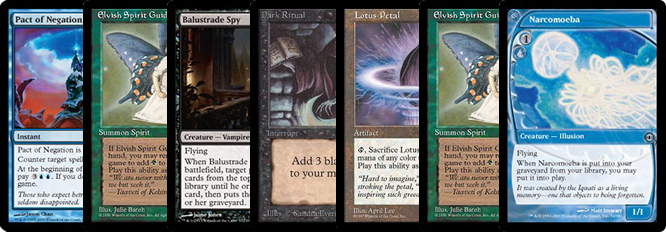
This is an easy turn one win with Pact of Negation protection:
1) Play Lotus Petal.
2) Cast Dark Ritual.
3) Remove Elvish Spirit Guide from game to generate a mana.
4) Cast Balustrade Spy.
5) Play Pact of Negation if necessary to protect it.
6) Put your library into your graveyard.
7) Two Narcomoebas trigger.
8) Sacrifice Balustrade Spy to cast Cabal Therapy on the opponent, and trigger two Bridges generating two Zombie tokens.
9) Sacrifice one of the Narcomoebas to cast another Cabal Therapy, and trigger two Bridges generating two Zombie tokens.
10) Flashback Dread Return on Angel of Glory’s Rise, and put Labatory Maniac and Azami into play.
11) Tap Azami to win the game by triggering Laboratory Maniac.
This hand is an easy turn one goldfish with Pact of Negation protection, and two more Therapies to clear out any lingering resistance.
Game 2:
My opening hand is:
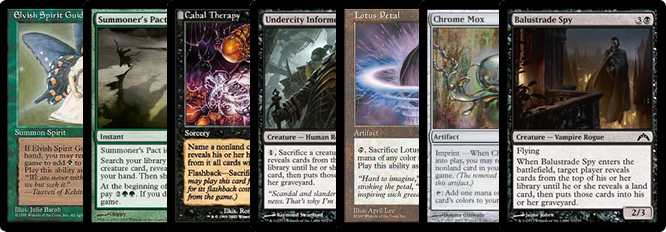
This is also an easy turn one goldfish:
1) Cast Lotus Petal.
2) Cast Chrome Mox, imprinting Undercity Informer.
3) Remove Elvish Spirit Guide from game to generate a mana.
4) Cast Summoner’s Pact for Elvish Spirit Guide.
5) Remove Elvish Spirit Guide from game to generate a mana.
6) Cast Balustrade Spy.
7) Repeat steps 6-11 from Game 1, except that three Narcomoeba’s will trigger.
The trick with this hand is deciding whether to play Cabal Therapy on turn one, and wait to play Spy until turn 2. For goldfishing purposes, this is not an issue. Another turn 1 Goldfish.
Game 3:
My opening hand is:

I was pleased to see this hand because I wanted to see how my singleton Charbelcher would play. Would it be useful, in a hand like this? Or would I regret having it when I needed something to imprint onto Chrome Mox?
This hand is an easy sequence:
1) Play Chrome Mox, imprinting Narcomoeba.
2) Play Mox Ruby.
3) Play Mox Opal.
4) Cast Dark Ritual.
5) Cast Goblin Charbelcher.
6) Play Pact of Negation if necessary to protect it.
7) Pass the turn.
8) On your Turn 2 upkeep, with Pact of Negation’s trigger on the stack, activate Belcher to win the game.
Turn 2 goldfish with Pact protection.
Game 4:
My opening hand is:
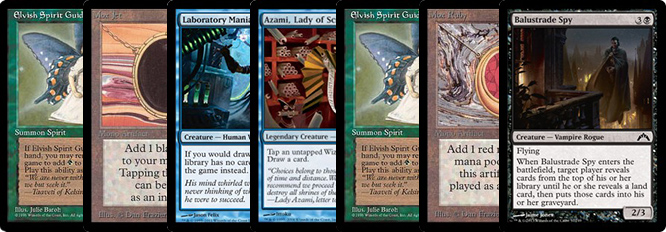
1) Play Mox Jet.
2) Play Mox Ruby.
3) Remove Elvish Spirit Guide from game to generate a mana.
4) Remove Elvish Spirit Guide from game to generate a mana.
5) Cast Balustrade Spy.
6) Put your library into your graveyard, triggering three Narcomoebas.
7) Play both Cabal Therapies on yourself to put Maniac and Azami in the graveyard.
8) Cast Dread Return on Angel, putting Maniac and Azami into play.
9) Activate Azami and win.
Another turn 1 goldfish win.
Game 5:
Narcomoeba, Mox Opal, Wild Cantor, Chrome Mox, Mox Pearl, Summoner’s Pact, Bridge from Below
This hand has no combo piece, and must be mulliganed into:
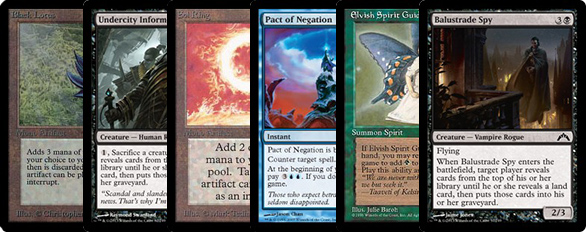
This is an easy turn one victory:
1) Play Black Lotus.
2) Play Sol Ring.
3) Cast Undercity Informer.
4) Play Pact of Negation if needed.
5) Activate Informer to put library into graveyard.
6) Repeat steps 6-11 from Game 1, except that three Narcomoeba’s will trigger.
Mulligan to 6, Turn 1 goldfish with Pact of Negation protection.
Game 6:
My opening hand is:
Azami, Lady of Scrolls, Mox Sapphire, Laboratory Maniac, Dark Ritual, Dark Ritual, Wild Cantor, Balustrade Spy
This hand would be fine if it had a way to generate black mana. This highlights the great need this deck has for turn one black mana. Even the two bad cards in hand can be dealt with using either Cabal Therapies on oneself or Phantasmagorian.
The lack of black mana makes this a mulligan into:
Pact of Negation, Bridge from Below, Bridge from Below, Mox Emerald, Undercity Informer, Elvish Spirit Guide
This hand, similarly, suffers from the exact same problem as the hand of 7 (no black mana).
I mulligan to these 5 cards:

All three hands lack black mana. The question is whether a hand of 4 would be any better. I decide to keep this hand, and draw a turn 2 Mox Jet, making this a turn 2 goldfish.
Mulligan to 5, turn 2 goldfish.
Game 7:
I opened this hand, the worst one yet:
Pact of Negation, Cabal Ritual, Mox Sapphire, Balustrade Spy, Angel of Glory’s Rise, Azami, Lady of Scrolls, Bridge from Below
This hand fails because it doesn’t have a black mana source to start off with, and because it has three cards you want in your library. It’s not keepable, and I mulliganed into:
Dark Ritual, Elvish Spirit Guide, Elvish Spirit Guide, Narcomoeba, Pact of Negation, Mox Pearl
Again, this is not keepable. It has no black mana source and no combo piece.
I mulligan into this hand of 5:
Sol Ring, Summoner’s Pact, Mox Emerald, Chrome Mox, Narcomeoba
This hand suffers the same problems, and I mulligan into this hand of 4:
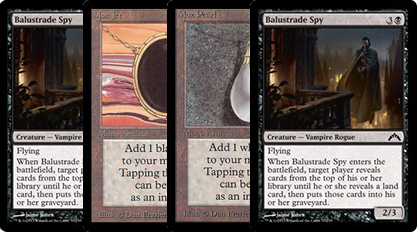
This hand has a black mana source and two combo creatures. The problem is that it doesn’t have enough mana to play them. I doubt a hand of three or less is likely to be better.
I keep it and draw Demonic Tutor on turn two, which I can play for Black Lotus, and use to win on turn 3.
Mulligan to 4, turn 3 goldfish win.
Game 8:
My opening hand is:
Mana Vault, Balustrade Spy, Narcomoeba, Undercity Informer, Azami, Lady of Scrolls, Mox Opal, Elvish Spirit Guide
This hand shows a recurring problem: the lack of black mana.
I mulligan to:
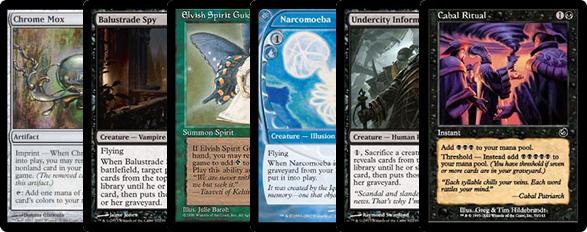
1) Cast Chrome Mox, imprinting Spy.
2) Remove Elvish Spirit Guide from game to generate a mana.
3) Cast Cabal Ritual.
4) Cast Undercity Informer.
5) Pass the turn.
6) On turn 2, activate Informer.
7) Repeat steps 6-11 from Game 1, except that three Narcomoeba’s will trigger.
Mulligan to 6, turn 2 win.
Game 9:
My opening hand is:
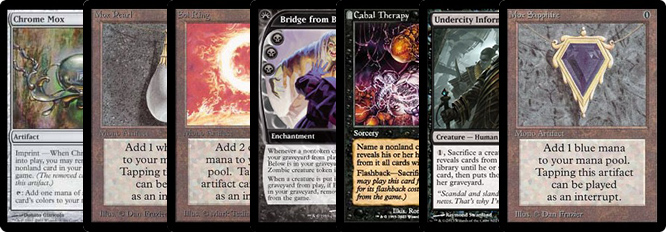
This is an easy turn one goldfish:
1) Play Chrome Mox, imprinting Bridge From Below
2) Play Mox Pearl
3) Play Sol Ring
4) Play Mox Sapphire
5) Cast Undercity Informer and activate it.
6) Repeat steps 6-11 from Game 1, except that three Narcomoebas will trigger.
Turn 1 goldfish.
Game 10:
My opening hand is:
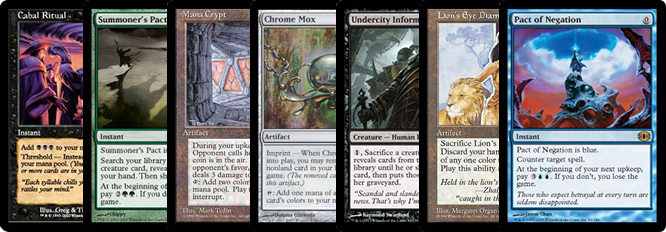
1) Play Chrome Mox, imprinting Cabal Ritual.
2) Play Mana Crypt.
3) Play Lion’s Eye Diamond.
4) Cast Undercity Informer.
5) Play Pact of Negation if needed to protect it.
6) Play Summoner’s Pact to find Elvish Spirit Guide.
7) Remove Elvish Spirit Guide from game to generate a mana.
8) Repeat steps 6-11 from Game 1, except that three Narcomoebas will trigger.
Another turn 1 goldfish win with Pact of Negation protection.
Goldfishing Summary
Game 1: Turn 1 goldfish with Pact of Negation protection.
Game 2: Turn 1 goldfish.
Game 3: Turn 2 goldfish with Goblin Charbelcher with Pact of Negation protection.
Game 4: Turn 1 goldfish.
Game 5: Mulligan to 6, Turn 1 goldfish with Pact of Negation protection.
Game 6: Mulligan to 5, Turn 2 goldfish.
Game 7: Mulligan to 4, Turn 3 goldfish
Game 8: Mulligan to 6, Turn 2 win.
Game 9: Turn 1 goldfish
Game 10: Turn 1 goldfish with Pact of Negation protection.
That’s 6 turn 1 kills (3 with Pact of Negation protection), 3 turn 2 kills (1 with Pact of Negation protection), and 1 turn 3 kill after a mulligan to 4. Two of those turn two kills involved resolving your combo piece on turn 1.
If these numbers are accurate, that makes this the fastest Vintage deck I’ve ever goldfished with disruption maindeck. Meandeck Tendrils had about a 50% (maybe even 60%) turn one, but that’s with no protection and that’s if you play it perfectly. This deck has a bunch of protection, and isn’t even fully tuned.
Based upon the games I goldfished, it seems pretty clear what this deck’s structural needs are: a black mana source to begin the combo process. This deck may need a 3rd Mox Opal to help get there. If that’s not enough, it may even need more Wild Cantors or Chromatic Sphere effects.
I may also have too many combo pieces. It may be possible to shave one off and add a 3rd Cabal Therapy.
Other than that, I was pretty happy with this maindeck. I look forward to seeing what tournament competitors come up with!
Conclusion
This deck is the fastest deck in Vintage I’ve ever seen. Meandeck Tendrils could win somewhere above 50% of the time on turn 1, and I think a properly tuned list of this can probably do the same. Unlike Meandeck Tendrils, however, this deck can win through disruption, and has its own disruption.
It’s faster and more consistent than Meandeck Tendrils, and certainly faster than any Academy deck (they had more turn 2 goldfishes than turn 1 goldfishes) from the late 1990’s. The original Burning Tendrils with 4 Lion’s Eye Diamonds may approach this speed, but I don’t think it was quite that fast (although Randy Buehler claimed a variant was almost that fast).
This is may be the fastest Type I/Vintage legal deck since 1993. It can set up and execute a turn one kill through resistance more consistently than probably anything in this format, arguably since the days before a Restricted list.
It’s safe to say that many people will write this off as a glass cannon. I have serious reservations about ever playing a deck like this in a tournament as well, but not because it’s a glass cannon. I don’t think this deck necessarily folds to the slightest pressure, but I do think it has a very, very low chance of winning certain matchups, like Workshop on the draw.
Moreover, while it may be faster than Belcher, it trades off that speed with the drawback of being vulnerable to graveyard disruption. You lose to a well timed Extirpate (which, granted, no one in Vintage plays at the moment).
The one cautionary warning I would offer is this: there have been ample examples of decks in both legacy and Vintage that have been written off as glass cannons, and have proved anything but. Dredge, Flash, and Belcher are three examples. While I would be surprised if this started dominating tournaments or winning large events repeatedly, I wouldn’t be shocked to see this crack Top 8s now and again.
In the next week or so I will conduct the same process for Legacy Rogue Hermit for Eternal Central, so be sure to check back!
Until Next Time,
Stephen Menendian
(Editor’s Note: We have updated this article with an updated sideboard strategy as of 02-14-2013 per the author’s recommendation.)

